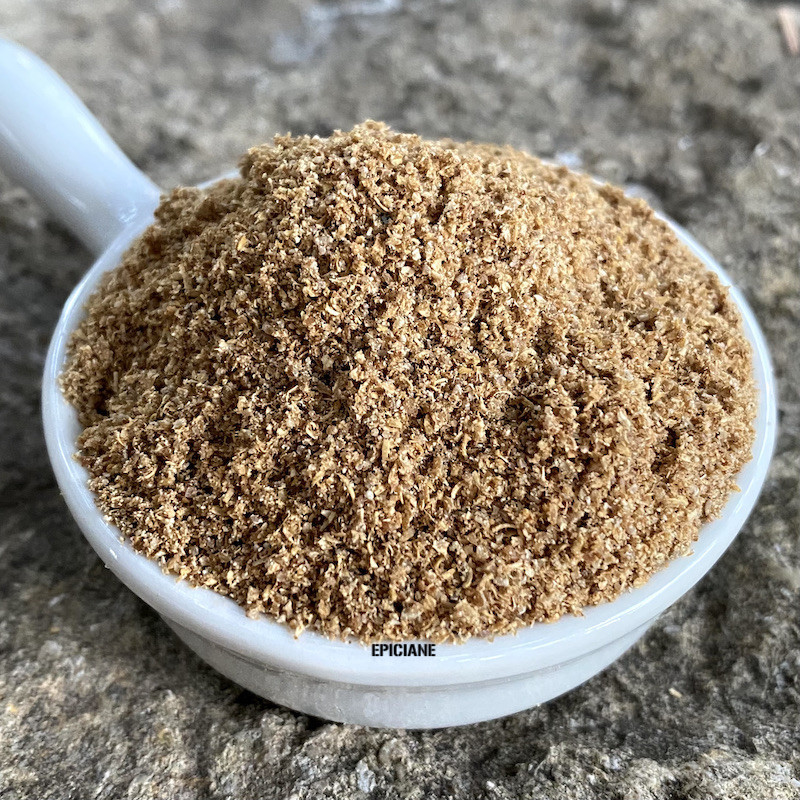
Reference: 20807504


Its flavor is fresh, almost slightly mentholated.
It is almost always present in Maghreb cuisine (couscous, tagines), in Asian cuisine, and in dishes referred to as "à la grecque."
 Delivery
Delivery
Mondial Relay
 Returns
Returns
See conditions
 Payments
Payments
100% secure
Produit livré en sachet refermable
Uses in Cooking:
The flavor of ground coriander is fresh, mild, and almost slightly mentholated, identical to that of the seeds that are ground to produce it. Its taste is somewhat different from that of the leaves.
It is a staple ingredient in spice blends that enhance couscous, tagines, and Indian curries! You will also find it in the Asian five-spice blend.
You can simply sprinkle it into any cooked dishes where you want to bring out its fresh flavor. However, for marinades, poaching liquids, olives, and pickles, it is better to use whole seeds.
In infusions, it is also the seeds that are used for their digestive benefits. They are often combined with other herbs that also aid digestion, such as dill, fennel, green anise, caraway, and star anise.
Who am I?
Origin: Romania
Scientific name: Coriandrum sativum
Other names: Arabic parsley, Chinese parsley ("parsley" due to the shape of its leaves, which resemble those of this plant, and "Arabic" or "Chinese" because the inhabitants of these two regions traditionally consume it in large quantities).
Coriander is an annual herbaceous plant from the Apiaceae family (Umbelliferae), measuring 30 to 60 cm in height. The foliage and stem are light green, while the flowers, arranged in typical umbels of this plant family, are white or pale pink-lavender. The lower leaves begin to wilt before the fruits reach maturity. The scent of the plant, although delightful, is considered by those who dislike it to resemble that of a crushed bug!
This aromatic plant is cultivated in temperate zones worldwide, up to an altitude of 2200 m, and is used in numerous dishes in Asia, North Africa, Latin America, and in dishes referred to as "à la grecque."
The leaves are more often used fresh or dehydrated, while the seeds (or fruits) can be left whole or ground into powder. When fresh, the seeds are green, but they turn beige during maturation and drying. They measure a few millimeters in diameter and have a somewhat hollow texture.
Even the roots of the plant can be used, chopped and added to Thai dishes!
An essential oil is extracted from the plant, used in aromatherapy, perfumery, and cosmetics.
As for the leaves, they are an excellent source of vitamin K.
A Little History:
The name "coriander," which appeared in the 12th century, comes from the Latin "coriandrum." The origin of coriander is uncertain. It grows wild in a vast area of the Near East and southern Europe.
Some seeds (or fruits) have been found in a Neolithic cave in Israel, making it the oldest archaeological trace of coriander, dating back about 6000 years before Christ. It has also been found in the tomb of Tutankhamun and in other ancient Egyptian burials. Since this plant does not grow wild in Egypt, it is likely that it was cultivated there at the time. It is believed to have been cultivated in ancient Greece for at least 2000 years before Christ.
Data sheet
Reference: coriandreE
Reference: 20721302
Reference: anisvertM
Reference: Harissa
Reference: 208022801
Reference: 00036306-0001
Reference: 3N7201902
Reference: 20211003
Reference: 3N7153402
Reference: EPI2301003
Reference: coriandreE
Reference: 6L5609803
Reference: fenouilE
Reference: 30803202
Reference: 20721302
Reference: 20815801
Reference: 208033101
Reference: 10N7738802

Its flavor is fresh, almost slightly mentholated.
It is almost always present in Maghreb cuisine (couscous, tagines), in Asian cuisine, and in dishes referred to as "à la grecque."